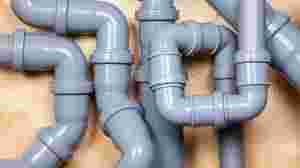Plastic pipes have become a standard choice in modern construction for water supply, drainage, HVAC systems, and more. Their growing popularity is no coincidence. From cost savings to corrosion resistance, plastic pipes provide clear advantages over traditional materials like metal or concrete. Here's a detailed breakdown of the seven key benefits of using plastic pipe in construction.
1. Corrosion Resistance
One of the most important benefits of plastic pipes is their resistance to corrosion. Unlike metal pipes, plastic does not rust or degrade when exposed to moisture or chemicals. This feature is particularly useful in environments where the pipes are exposed to harsh conditions, such as underground or in industrial facilities.
Because plastic pipes don’t corrode, they maintain their structural integrity over time. This reduces the risk of leaks and system failures, cutting down on maintenance costs and service interruptions. Pipe manufacturers often highlight corrosion resistance as a key selling point.
2. Lightweight and Easy to Handle
Plastic pipes are significantly lighter than their metal counterparts, making them easier to transport and install. This lightweight nature reduces the need for heavy machinery and large crews, which can translate into cost savings and faster installation times.
Installers can often handle plastic pipe fittings and pipes manually, reducing labor fatigue and improving on-site safety. For large-scale construction projects, this logistical efficiency becomes a major advantage.
3. Cost-Effectiveness
Plastic pipes tend to be more affordable than metal or concrete pipes. The lower cost of raw materials and the simpler manufacturing process make plastic pipes a budget-friendly option for builders and developers.
Beyond initial purchase, plastic pipes often have lower lifecycle costs. They require less maintenance, have fewer repair needs, and last longer in many applications. These financial advantages make plastic pipes a smart long-term investment.
4. Chemical Resistance
Plastic pipes are highly resistant to a wide range of chemicals. This property makes them ideal for industrial and laboratory settings where various fluids and gases are transported.
PVC pipe fittings, in particular, are commonly used in chemical processing plants and wastewater facilities because they can handle exposure to acids, alkalis, and other reactive substances without degrading.
This resistance to chemical damage ensures consistent performance and safety over time, further reinforcing plastic pipe as a dependable choice.
5. Versatility and Wide Range of Applications
Plastic pipes come in many forms—PVC, CPVC, HDPE, PEX, and more—each suited to specific types of projects. This diversity allows engineers and contractors to select the best pipe for the job, depending on the pressure, temperature, and environmental conditions involved.
Plastic pipe fittings can be customized for nearly any application, from residential plumbing to high-pressure industrial systems. Their adaptability makes them an all-purpose solution in construction, simplifying procurement and reducing the need for multiple types of piping systems.
6. Smooth Interior Surface
The interior surface of plastic pipes is smooth and non-porous, which minimizes friction and promotes efficient flow of water or other substances. This reduced friction helps maintain water pressure over long distances and minimizes energy consumption in pumping systems.
Smooth surfaces also discourage the buildup of sediment, scale, or biofilm. This makes plastic pipes particularly useful in potable water systems, where cleanliness is essential. The efficiency of flow contributes to the overall performance of plumbing and HVAC systems.
7. Longevity and Durability
Plastic pipes are designed to last. In many applications, they can perform reliably for 50 years or more. Their resistance to corrosion, chemical attack, and physical wear contributes to their extended lifespan.
Plastic piping systems also handle thermal expansion and contraction well, making them suitable for a wide range of climates. The flexibility of materials like PEX and HDPE further enhances durability, especially in freeze-thaw environments.
Builders and engineers trust plastic pipe not only for its current performance but for its proven track record over decades. Long life means fewer replacements, less disruption, and a better return on investment.
Conclusion
The use of plastic pipes in construction offers a practical combination of durability, cost savings, and performance. Their advantages—corrosion resistance, lightweight nature, chemical compatibility, and more—make them a go-to material for modern projects.
As pipe manufacturers continue to innovate, the options for plastic piping systems are expanding. Whether it’s residential plumbing or industrial infrastructure, plastic pipes are shaping the future of construction.
With the growing use of plastic pipe fittings and pvc pipe fittings, it’s clear that plastic will remain central to efficient and sustainable building systems. The benefits are real, and the momentum is only growing.




